We've finally managed to put the bucket mushroom grow together! The hardest thing is gathering the ingredients and working out a system. I'm going to explain how we did it and at the end the problems we came up against at the very end. I hope it is simple enough for anyone to follow!
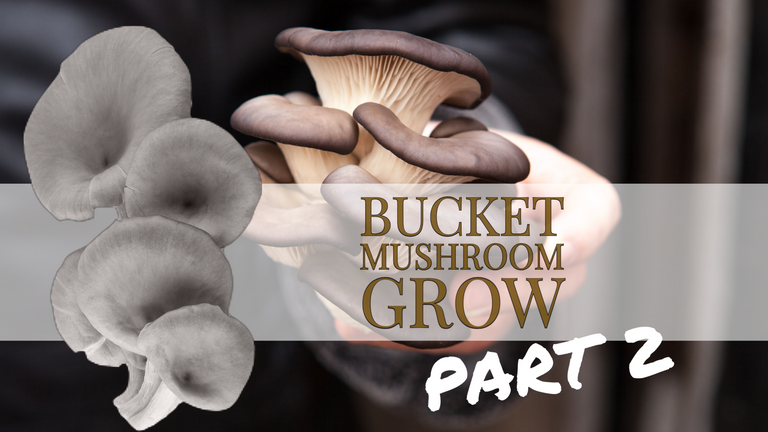
1. Gather Your Ingredients
- Sanitiser
- Thermometer
- Micropore Tape
- 4 Litre buckets
- Hydrated lime (builder's lime NOT garden lime)
- A heating element or way to heat water
- A pillowcase
- An esky
- Straw (NOT peastraw)
- Hardwood sawdust
- A drill and a step drill bit
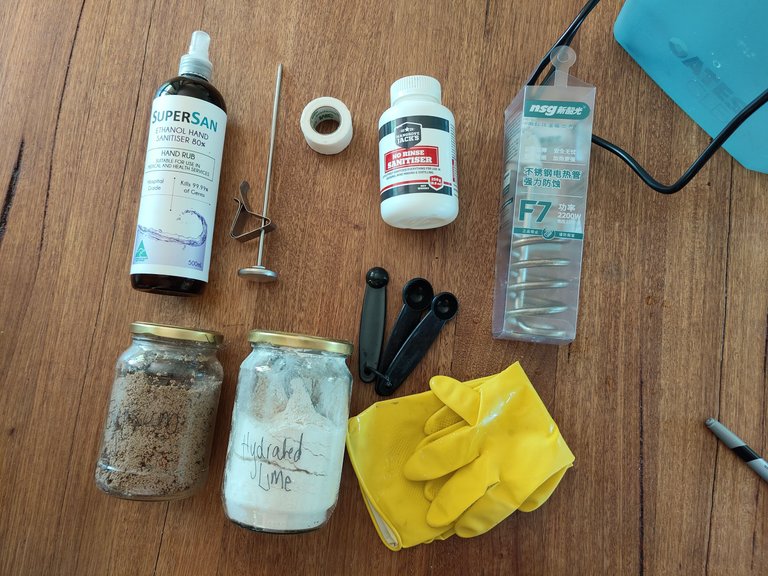
2. Heat The Water
We used a heating element and the esky took about an hour and a half to heat. This gave us time to do everything else. It has to be heated to 80 degrees but not more, and should remain between 60 - 80 degrees for an hour in the esky.

3. Make Your Substrate
Finely chop the straw with scissors to an inch or two in length. Add the sawdust, gypsum and hydrated lime. Use gloves and goggles. Then stuff in your pillowcase. YOu don't need to sterilise at this point as it will all be pasteurized in the hot water. Here's how you will calculate it, according to the recipe from Milkwood Permaculture, that I'm following. The volume is the volume of the buckets you are using. Mix really really well. You should add some warm water to get it all wet but not dripping.
- Straw: 50% of total volume.
- Hardwood sawdust: 50% of total volume.
- Gypsum: 1 teaspoon for every 4 litres/1 gallon of
total volume. - Hydrated lime: 1 tablespoon for every 4 litres/1
gallon of total volume. For oyster mushrooms only
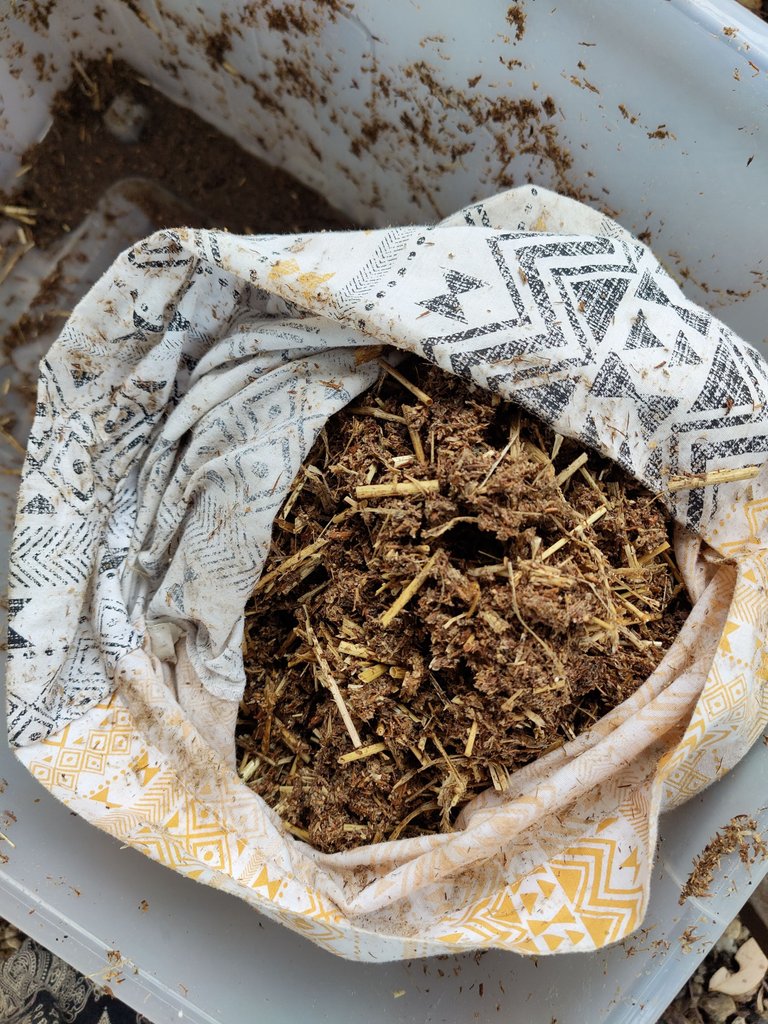
3. Pasteurize your substrate
Tie a rope around your pillow case to secure and ease into the hot water. Shut the lid and leave it for an hour. Then pull out of the water and hang it so it drips pretty dry. This is field capacity - enough water for it to be wet, but not waterlogged and dripping. As it cools you can use your gloved and sterilised hands to squeeze extra liquid out.
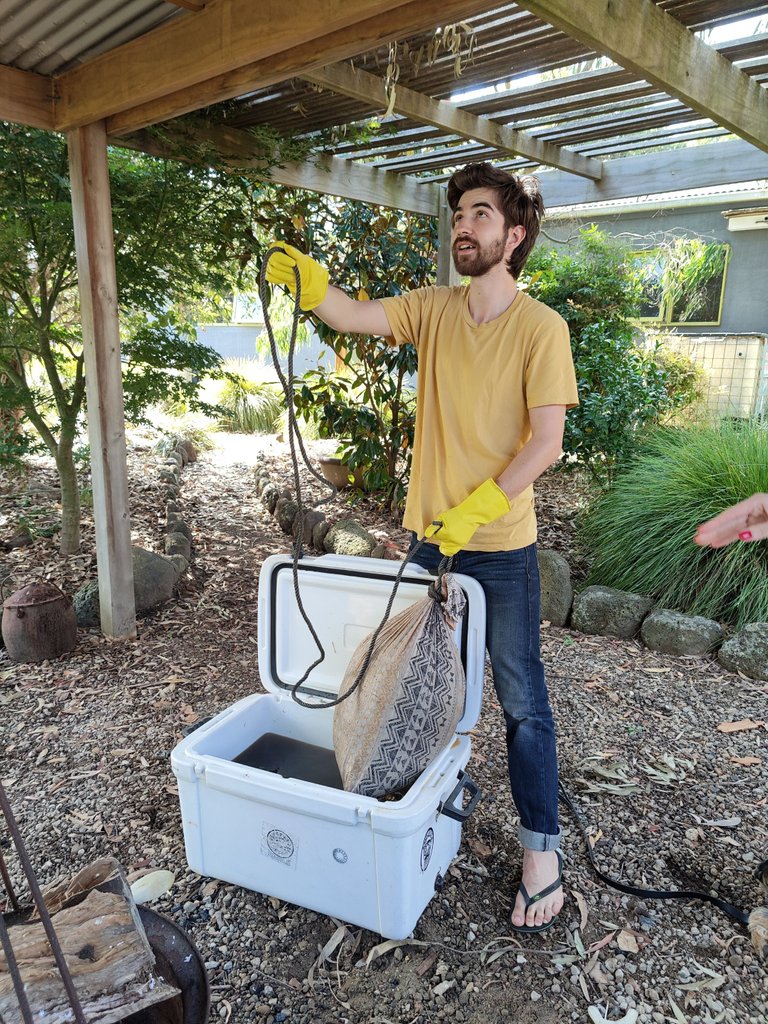
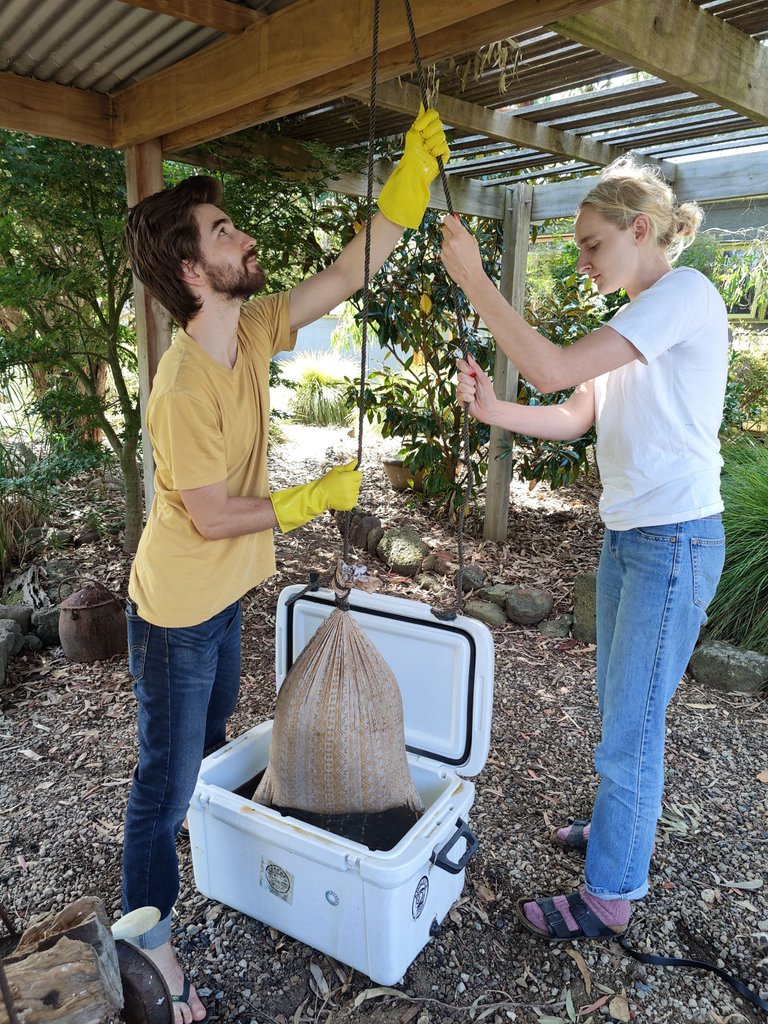
My son figuring and his girl trying to figure out how to hang it
4. Prepare the Buckets
You need a 1/4 inch step drill bit for this. Drill four holes about a third of the way up the bucket in regular intervals, and 1/4 of the way down. This is where your mushrooms will escape, growing from the mycellium.
Tape them off with micropore tape.
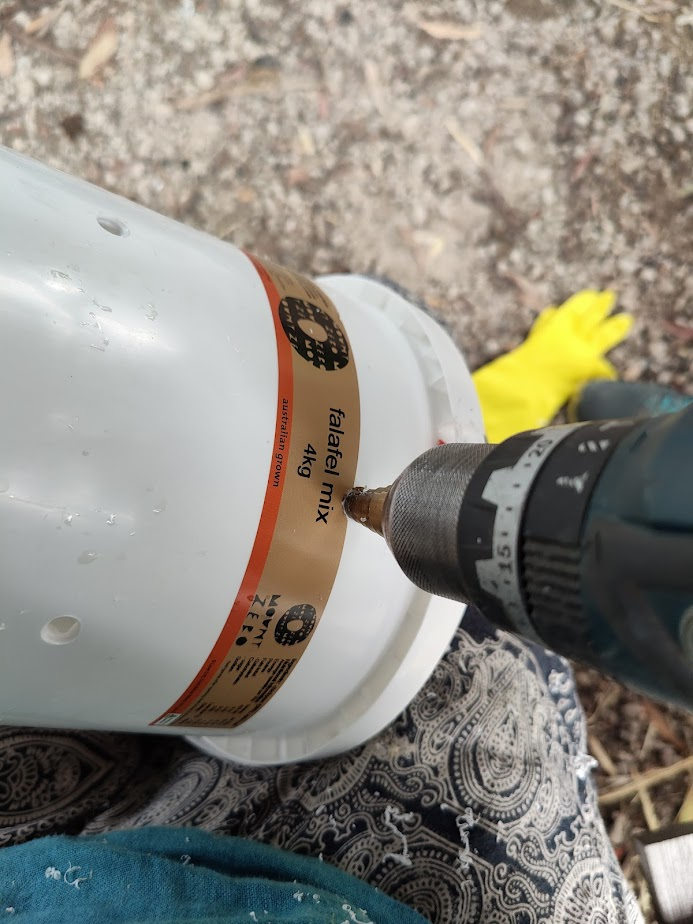
5. Add the Spawn
At this point, it's advisable to bring everything inside. We prepared the kitchen bench by sterilising it with an 80 percent ethanol spray. I got a big tub and sterilised that, and sterilised all the buckets really well. Also sterilise your hands! Everything must be super clean.
Empty out the pillow case into a big tub so it cools down more. YOu don't want to pasteurise or kill the spawn.
Then you add your spawn. Spawn is NOT spores!
grain/mycelium mixture is called spawn, and spawn is used to "seed" mushroom compost. Most spawn is made with mycelium from a stored culture, rather than mycelium whose parent was a spore.1*
Here's where we got ours from. We're also using oyster mushrooms as they are easy to grow.

You use 10 percent of the total volume in spawn. Mix it through really really well.
Then, stuff into your buckets. You might have noticed the total volume comes out at over 100 percent - that's fine, it's just easy to work out that way - and you can pack it in pretty tight. Wipe the buckets clean.
Leave in a Dark Place for 7 - 10 Days
You can check after a week - the mycellium should be running through the substrate by now. As I havent got this far, I'll leave it for now until we start getting mushrooms!
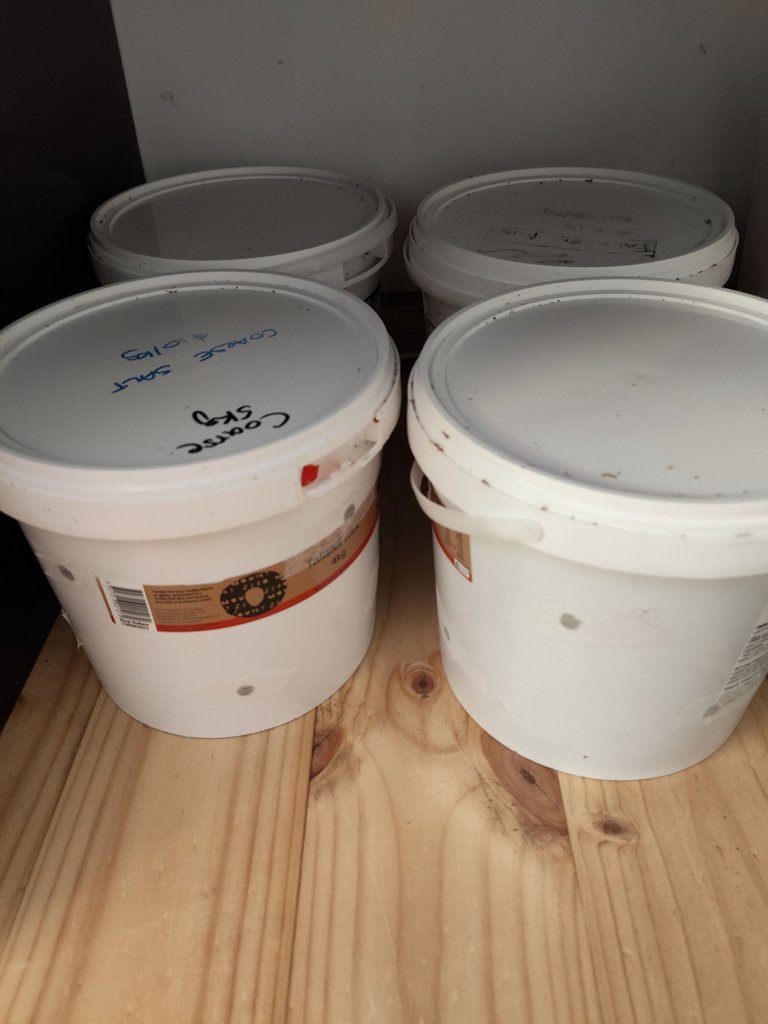
Observations
- That water takes AGES to boil! But the element method works well and is worth the investment. We got ours here for about 20 AUD.
- Chopping the straw takes ages. In retrospect I would have prepared the straw and buckets another day, ready to go. I think preparation is the key. Having lots of little jobs done before you start would make the whole process easier - you could just put the water on to boil, set the alarm, and go about doing whatever else you want to do with your day.
- You really ahve to sterilise everything. I'm terrified I'll open the buckets in a week and things will be mouldy!
- Yes, you can use other substrates, like cardboard, but this is the recipe I'm following. You can also add bran to this but they advise against it until we get a handle on this method.
- I found the buckets at my local wholefoods. It took ages to find them - is there a global bucket storage or what? 4 - 5 litres is the ideal size I think.
- If you can't find sawdust (and don't use pine or any softwoods) you can do it in straight straw apparently.
- The location for it to start to grow should be protected from extreme temperatures (below 5 °C (40 °F) or above 32 °C (90 °F). Ideally around 20 - 25 °C (70 - 75 °F), according to Milkwood Permaculture. You'll need it more light and humid for the actual mushrooms to start to fruit.
Remember this is the first time we've done this so if you're a mushroom growing expert, go easy on us. If you have any questions I can endeavour to answer them!
Excited about Part 3 - hopefully in a few weeks time!
With Love,


The Fungi Lovers Community: Home of #FungiFriday


The Herbal Hive Community
Are you on HIVE yet? Earn for writing! Referral link for FREE account here!

So much work! I knew mushrooms were finicky but that seems rather excessive....until I think about all yeast/spore grown foods. Fermented foods and drinks also require a thorough sterilization process. Cheeses are also fussy but I never see it like that. After all these years I just do it. Excited with you about your fungi farm!!
My goodness what a process! The sterilization is daunting!
But seeing the mycellium is fascinating. The first year I used wood mulch in the New Herb garden, it was cool to see it running all through the mulch after then end of the season.
It IS all a process that's for sure - I nearly gave up! But now I have all the things in the one place in a tub ready to go for next time and once I've done it once, I can be more organised next time!!!!
Oh yes, I get it in my mulch too! Sometimes it looks like vomit!
Wow, this is so impressive! I had no idea. Not really something that feels doable for me at the moment but I keep a lot in the back of my mind and you are a big inspiration. Yesterday I felt I wanted to learn to make my own body lotion, something I have never felt before. So I'm walking in your footsteps, even if it feels like baby steps 🙂
And so nice to see a picture of your son 🙂
xx
Thanks so much, that means a lot to me! I think we're all learning from each other!
That is the beauty of Hive, we are all learning from each other ❤️
very cool. I don't understand anything about the process. but I'm going to stick around and learn more about mushrooms.
Yes the process is hard! The course was great as it gave me a solid foundation of what mycellium is and so on. Have you seen Fantastic Fungi on Netflix? It's really cool and helps you understand so much!!! Then it makes sense when you get around to growing them.
hummm very interesting I think I will watch Fantastic Fungi as soon as possible. thanks for the tip!!! and I will continue following your content thank you very much!!
Thanks a lot. Yes if you can watch it I know you will enjoy it! It was very inspiring.
It looks like the holes have a clear tape over them?
If too many of the buckets seem to get contaminated try filling the holes with wax or using a tape that blocks ultra-violet light. The tape is always going to be dodgy because of the adhesive's ability to collect contaminates before being fully applied.
Just an idea there if you run into trouble. 🤠
Edit:
P.S. To be clear I am basing that off of how logs are treated and have no experience with the bucket method.
It's micropore tape. It was sealed beforehand, my hands were sterilised, as were my gloves and the bucket around the holes, and then the whole thing was wiped again with sterilisation fluid (80 percent ethanol) so if mould gets in I'll be upset!
Now that is some precautions!
I've done this a few times. Usually I just buy the kits and wait for the ideal time of year.
Yes, the kits are great. But they are 35 bucks each - the spawn (inocoluated grain) is 40 bucks a bag which will do probably 40 buckets at least, which means about 40 times more mushroooms! And I can re-use the buckets - less plastic waste from the bags as well. It's a complicated process but I'm hoping I can get a handle on it and do it every year!
This post has been manually curated by @bhattg from Indiaunited community. Join us on our Discord Server.
Do you know that you can earn a passive income by delegating to @indiaunited. We share 100 % of the curation rewards with the delegators.
Here are some handy links for delegations: 100HP, 250HP, 500HP, 1000HP.
Read our latest announcement post to get more information.
Please contribute to the community by upvoting this comment and posts made by @indiaunited.
Wow, I am loving that you are sharing this, there is a lot to think about. Living in a vehicle does not make it easy when you need to keep temp constant, (as you know)but I am really thinking a lot about that and the different solutions. But I love that you are growing them in buckets. Looking for ward to the next update. I'm so jealous right now xxxxxx
Oh I thought of you living in a truck. I think if you had an esky, you could boil the water and put it in there rather than the element, in a big stock pot or something. That might work. I think there's also a fermentation method, I'll look into it for you!
👍👍👍👍